Summary The veterinary activities went on successfully during the month of April, several cases of zebras and giraffes trapped with snares and with various injuries were handled successfully in Naivasha and Masai Mara area
Summary
The veterinary activities went on successfully during the month of April, several cases of zebras and giraffes trapped with snares and with various injuries were handled successfully in Naivasha and Masai Mara area. Investigations of mange infestation in cheetahs and other wildlife species in Masai Mara continued during the month. A lion that sustained critical injuries in Mara Triangle was also treated and recovered. We greatly acknowledge the support of the David Sheldrick Wildlife Trust (DSWT) towards provision of veterinary services to wildlife in Mara and other parts of Central Rift, through this support, the veterinary unit in Mara has been able to respond to all reported cases that require veterinary attention in Mara and Central Rift region.
Treatment and removal of a snare from a Giraffe in Annex Sanctuary in Naivasha
This was an adult male giraffe that had been sighted with a tight wire snare on the right front leg. The wire was tight and had inflicted traumatic injury to the giraffe which had difficulties in movement and could be seen limping with a lot of pain. The case had been reported to the vet by KWS rangers at the Annex sanctuary.
Chemical restrain
It was then captured by chemical immobilization through darting using 14mgs of etorphine hydrochloride combined with 30mgs of Xylazine hydrochloride. It took about 6 minutes to become recumbent.
The wire was then cut off using a wire cutter and the inflicted wound treated topically using hydrogen peroxide and a tincture of iodine then sprayed with oxytetracycline spray. Blood samples were obtained from the jugular vein that will be analyzed in the lab for health monitoring purposes. 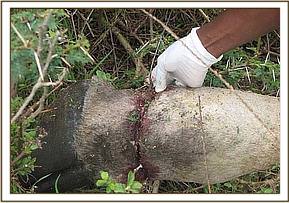
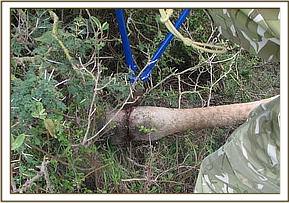
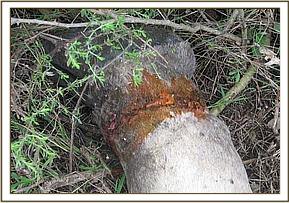

Anaesthesia revival
After treatment the animal was revived from anaesthesia using 5mgs of Atipamezole hydrochloride combined with 36mgs of Diprenorphine hydrochloride administered through the jugular vein. It woke up after about 3 minutes and joined others.
Prognosis
Prognosis was good after removing the wire which was constantly irritating the wound and treating the wound in good time the giraffe was still in good body condition and had better chances of recovery from the injury.
Rescue of snared zebra in Crater Lake sanctuary in Naivasha
This was a case of an adult female zebra that had a loose wire snare round the neck. The animal was reported by the KWS warden at Naivasha station and the KWS rangers assisted the vet team to search for the zebra until it was found.
It was immobilized by darting using 5mgs of etorphine hydrochloride combined with 80mgs of Xylazine hydrochloride and it took about 5 minutes to become recumbent. After it was fully anaesthetized and went recumbent, the eyes were covered by a blind-fold and water poured onto it to help control the body temperature. The loose wire was then cut using a wire cutter. 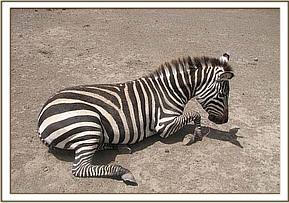
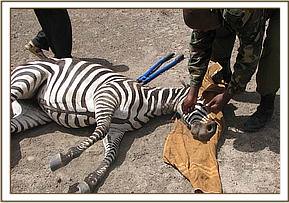

Rescue of a zebra with a snare round the neck in Crater Lake sanctuary in Naivasha
The animal was later revived from anaesthesia using 12mgs of Diprenorphine hydrochloride combined with 5mgs of Atipamezole hydrochloride, It took about 2 minutes to rise up and joined others.
Another female zebra was also successfully captured, desnared and treated in Longonot area, the snare was so tight on the right hind leg and had inflicted a severe injury on the limb causing lameness to the animal. It was captured by darting and the wire cut off and the wound treated appropriately then revived from anaesthesia and released. 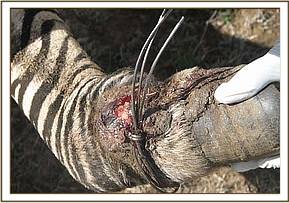
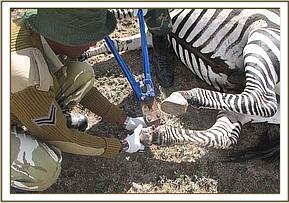



Treatment of an injured male lion in Mara Triangle
Lions are very much prone to traumatic injuries while hunting for food, often they sustain fractures or severe wounds and may even die in some instances. The adult male lion at Oloololo gate in Mara Triangle was reported to have sustained severe injuries on one of its front legs, it was in accompany of another male lion, and it was in a very painful situation that required an immediate veterinary attention. The vet team from Mara managed to find it and it was successfully captured and treated for the injuries. 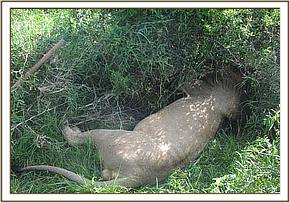
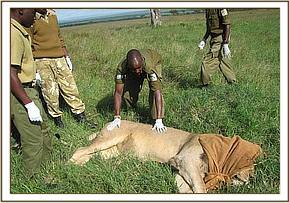
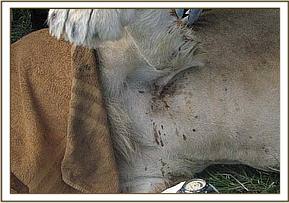

Chemical restrain
The lion was captured using 450mgs of Xylazine Hcl combined with 450mgs of Ketamine Hcl, it was darted on the right thigh and became recumbent after about 10 minutes. It was then blindfolded and transferred to a cool shade under a tree from where it was examined and treated.
Examination and treatment
The lion was in a good body condition and the vital physiological parameters were monitored and recorded as follows;
Respiration rate 30 cycles/minute, deep and regular, Pulse rate 76 beats/minute, strong and regular, body temperature of 38 degrees Celsius, buccal, conjuctiva and anal mucosal membranes had pink normal colour, capillary refill time (CRT) was 2 seconds. External parasites like ticks and lion flies were found on the skin.
The lion had sustained injuries on the left front leg, it had deep wounds penetrating into the muscles and the affected limb was already swollen and eliciting a lot of pain to the animal while walking.
Treatment
The wounds were well debrided using hydrogen peroxide and treated by tincture of iodine applied topically. The animal was further treated using antibiotics (Amoxycillin), multivitamins and dexamethasone. Eyes were well treated with Opticlox eye ointment to prevent desiccation and infection.
Samples collection
Blood samples were collected in EDTA coated tubes and plain tubes coated with clot retractor and kept in a cool box, tissue samples kept in ethanol solution and ectoparasites such as ticks and lion flies collected and stored in 70% ethanol. These samples were then processed and stored in KWS lab for further analysis and for future reference.
Anaesthesia Revival
The animal was revived from anaesthesia after about 40 minutes using 20mgs of Atipamezole Hcl administered intramuscularly, it took about 10 minutes to rise up, it was still in pain and unable to hunt but would be supported by the other male lion that stayed with it. Prognosis was good because there was no much infection on the injured leg and it had not developed septiceamia, it also had good appetite. It was to be monitored on a daily basis by security rangers who would report on its progress regularly.
Treatment of an injured Giraffe in Kawai area in Mara
The Mara Conservancy patrol team reported a case of a giraffe that had a severe wound on the right front leg. The giraffe was found grazing alone near Kawai trading centre at a GPS location S- 01. 13. 135; E- 034. 70. 590, over the Mara Triangle escarpment.
It was an adult male giraffe that had a deep penetrating wound on the interdigital space of the right front leg, it had stayed with the wound for a few days and septiceamia had already set in. It had difficulties in walking and could be seen lying down most of the time unable to feed properly, it had therefore lost much of its body condition and became extremely weak.
Chemical immobilization and capture
The giraffe was captured by darting using 13mgs of etorphine Hcl combined with 30mgs of Xylazine Hcl, it took about 5 minutes to become recumbent. Further restraint was achieved using ropes.
Treatment
The wound was cleaned with a lot of water and debrided using 10% hydrogen peroxide solution followed by an application of tincture of iodine and oxytetracycline spray. The wound was already septic and had maggots which were flushed out using water and hydrogen peroxide. Antibiotics and antinflammatory drugs were also administered parenterally through the muscles to enhance healing process.
Revival of anaesthesia and prognosis
The animal was revived from anaesthesia using 24mgs of Diprenorphine Hcl combined with 5mgs of Atipamezole Hcl administered through the jugular vein. Prognosis was poor because the injury was quite extensive and septiceamia had set in, the animal was in a very poor body condition and extremely weak. Security rangers in the area were requested to monitor and report the progress of that giraffe for further action.
Conclusion
Cases of wildlife injuries due to human-wildlife conflicts are still on the rise in Mara and Naivasha areas. Snaring of giraffes and common zebras in Naivasha is still a great threat to wildlife conservation in the area. The Central Rift veterinary unit through the support of Kenya Wildlife Service and the David Sheldrick Wildlife Trust (DSWT) continue to rescue as many animals as possible both in Mara ecosystem and other parts of Central Rift. The unit still requires a laboratory technologist and a refrigerator for storing biological samples from the field before being submitted to lab.
Report by: Dr. Domnic Mijele